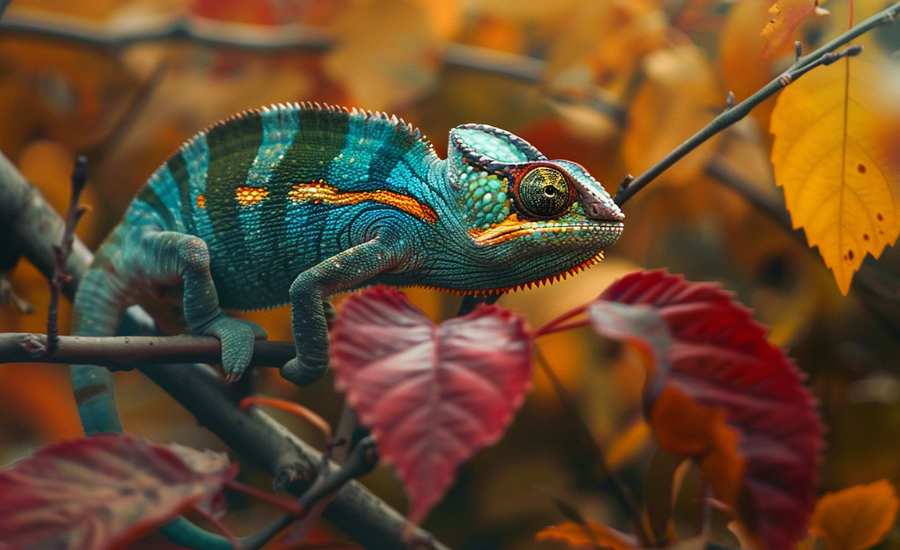Chameleónovité, or chameleons, are one of the most unique reptiles in the world. They are famous for their amazing ability to change colors, move their eyes in different directions, and catch insects with their long sticky tongues.
Found mostly in Africa and Madagascar, these creatures have special features that help them survive in their natural habitats. In this article, we’ll explore how chameleons change color, why they do it, and what makes them true masters of adaptation.
What is Chameleónovité?
Chameleónovité is the scientific family name for chameleons, a group of reptiles known for their color-changing skin, long tongues, and independently moving eyes. They belong to the family Chamaeleonidae, which includes over 200 species found mainly in Africa, Madagascar, southern Europe, and parts of Asia.
Chameleons are part of the lizard family, but they are quite different from ordinary lizards. They have gripping feet for climbing trees, curled tails for balance, and the incredible ability to change their skin color to communicate, regulate body temperature, or blend into their surroundings.
What actually makes a chameleon change color?
For a long time, people thought chameleons changed color mainly by moving pigments around inside skin cells. That’s partly true, but the full story is more interesting.
Chameleon skin has several layers of specialized cells. Two important ones are
- Chromatophores: pigment cells that hold dark (melanin), yellow, or red pigments.
- Iridophores: layers that contain tiny, mirror-like guanine nanocrystals. By changing the spacing of these crystals, chameleons change how light reflects off their skin and thus which colors we see.
When a chameleon is relaxed, the crystals are packed tightly and reflect shorter (bluer) wavelengths. When it’s excited, stressed, or signaling, the crystals spread out and reflect longer wavelengths (yellows, oranges, reds).
The combination of pigment shifts and crystal tuning produces the full range of colors. This structural color mechanism was clearly shown by researchers studying the skin’s nanocrystals.
Why do chameleons change color? (Not just camouflage)
Color change serves several real purposes beyond hiding:
- Communication: Males display bright colors to attract mates or warn rivals; subdued tones can signal submission.
- Thermoregulation: Darker colors absorb more heat; chameleons shift shades to warm up or cool down.
- Mood and health signals: Stress, illness, or hunger can affect color.
- Camouflage: Yes, blending with surroundings still matters, especially for predators or to avoid detection.
Examples: A male veiled chameleon may flash bright colors during courtship while turning darker when stressed. These color shifts are fast, expressive, and meaningful within chameleon “language.” (Several behavioral studies and care guides describe these patterns for popular species like the veiled and panther chameleon.)
The strange, useful eyes of chameleons
Chameleons have eyes unlike almost any other vertebrate. Each eye sits in a cone-shaped turret and can move independently, giving the animal nearly full 360° surveillance. They can scan with one eye while the other tracks prey, and then both eyes focus together to judge distance precisely before the tongue strike.
Recent work emphasizes that eye movement is flexible; chameleons can coordinate their eyes when needed for accurate depth perception and hunting. This combination of panoramic vision and precise binocular aiming helps them catch insects with stunning accuracy.
Why chameleons matter and why many are in trouble
Most chameleon species live on Madagascar and a few other places. They play important roles in ecosystems as insect predators and as part of food webs. But they face serious threats today:
- Habitat loss and land-use change: Farming, logging, and burning shrink suitable forest homes.
- Climate change: Shifts in temperature and rainfall can reduce where species can survive, especially the most range-restricted types.
- Illegal collection for the pet trade: Unsustainable capture harms wild populations.
- Fragmentation and wildfires: These make small populations even more vulnerable.
A 2024 modeling study found that many Madagascar chameleons face dramatic habitat loss from combined land-use and climate pressures, with some species predicted to lose nearly all suitable habitat without intervention. Field reports in 2025 also highlighted new chameleon finds that remind us how fragile their situations are and how urgent conservation is.
Latest trends: science, tech, and human use
- Science learning from chameleons: The nanocrystal mechanism inspired researchers to design “smart skins” and materials that change color in response to the environment useful ideas for soft robotics, sensors, and camouflaging fabrics.
- Conservation attention: New species discoveries and improved habitat models have pushed conservationists to prioritize hotspots and protected areas.
- Pet-care awareness: As public interest in chameleons grows, so does the emphasis on responsible, informed care: proper UVB lighting, humidity control, vertical space, and ethical sourcing are now central messages from vets and herpetologists.
Practical takeaways for readers
If you love chameleons or want to help, here are concrete actions:
- Support habitat protection: Donate to or follow reputable conservation groups working in Madagascar and other chameleon regions.
- Avoid buying wild-caught chameleons: Seek captive-bred animals and check seller credentials.
- Learn proper care before getting one: Chameleons require species-specific enclosures, UVB lighting, humidity cycles, and live food; poor husbandry can lead to high mortality rates.
- Spread awareness: Share accurate info about why chameleons are more than “just color-changing pets.”
FAQs
Q: Can chameleons change to any color?
A: Not any color, they have a specific palette based on pigments and structural colors. Their range varies by species and condition.
Q: Do chameleons change color to match every background?
A: No. Camouflage is one reason, but color changes are mainly for social signaling and body temperature regulation. Background matching is sometimes a side effect.
Q: Are chameleons good pets for beginners?
A: Generally, no. Many species need precise care (UVB, humidity, vertical space). Beginners should research heavily and prefer experienced keepers or start with hardier reptile species.
Q: What’s the biggest threat to chameleons today?
A: Habitat loss from land conversion and climate change are top threats, especially for Madagascar’s endemic species. Illegal trade and wildfires add pressure. Recent models indicate a substantial risk of habitat loss for many species.
Q: How fast can a chameleon change color?
A: Changes can occur in seconds to minutes, depending on the trigger (stress, signaling, temperature). The nanocrystal tuning mechanism allows rapid shifts in structural color.
Final thought
Chameleons are small creatures with big lessons. Their color-changing skin, remarkable vision, and delicate place in fragile ecosystems teach us about evolution, materials science, and the urgent need for conservation.
Whether you admire them from afar, read about new scientific discoveries, or care for one responsibly, chameleons are a living reminder of how finely tuned life can be and how important it is to protect it.
Discover smart ideas only on BusinessMusk.


